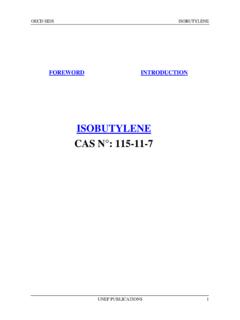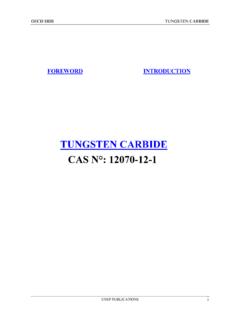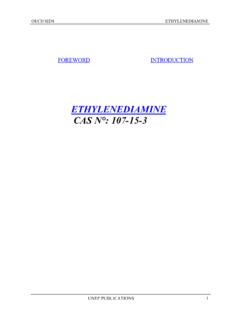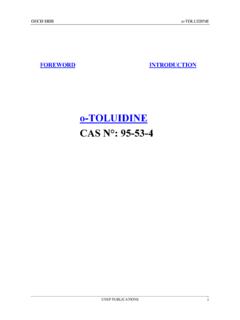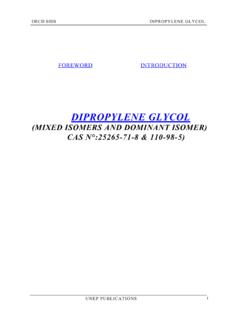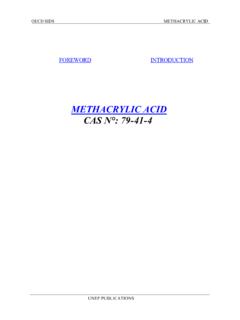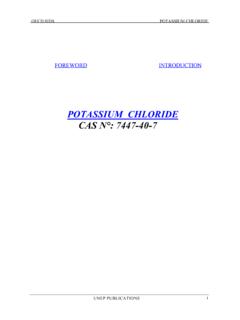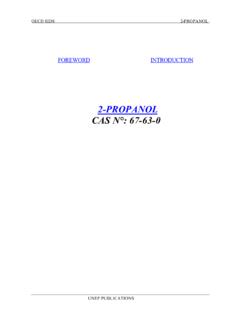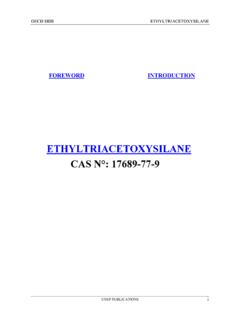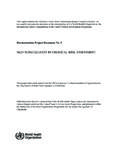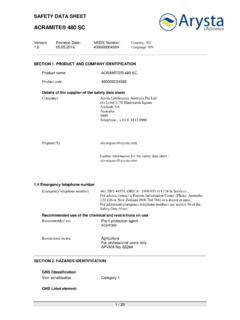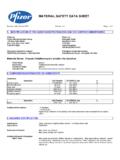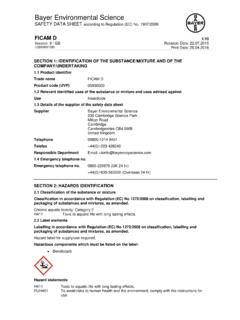Transcription of 1,1-DICHLORO-1FLUOROETHANE (HCFC) CAS N°: …
1 OECD SIDS1,1- dichloro -1 FLUOROETHANE ( hcfc )UNEP PUBLICATIONSFOREWORDINTRODUCTION1,1-DICH LORO-1 FLUOROETHANE ( hcfc )CAS N : 1717-00-6 OECD SIDS 1,1- dichloro -1-FLUOROETHANE UNEP Publications 2 SIDS Initial Assessment Report for12th SIAM (Paris, France June 27- 29, 2001)Chemical Name: 1,1- dichloro -1-fluoroethane ( hcfc 141b) CAS No.: 1717-00-6 Sponsor Country: United States/ICCA National SIDS Contact Point in Sponsor County: Mr. Oscar Hernandez US Environmental Protection Agency 401 M Street, Washington, 20460 History: hcfc 141b was presented at SIAM 12 were the recommendation of low priority for further work was agreed. Comments: Deadline for Circulation: Date of Circulation: 5/18/2001 OECD SIDS 1,1- dichloro -1-FLUOROETHANE UNEP Publications 3 SIDS INITIAL ASSESSMENT PROFILE CAS No.
2 1717-00-6 Chemical Name 1,1- dichloro -1-fluoroethane ( hcfc 141b)Structural Formula Cl2FC - CH3 RECOMMENDATIONThe chemical is currently of low priority for further work as it is subject to withdrawal under international activity (Montreal protocol). SUMMARY CONCLUSIONS OF THE SIARH uman Health The acute toxicity of hcfc 141b is low. No mortality was observed in rats receiving oral doses of 5,000 mg/kg. Dermal exposure of rats or rabbits to 2,000 mg/kg caused no mortality and no signs of toxicity. Single exposures of mice for 30 minutes indicated that the LC50 was between 296,640 and 494,400 mg/m3 (61,800 ppm to 103,000 ppm) and the 4-hr LC50 in rats was 62,000 ppm (approximately 297,600 mg/m3). Also, a 6-hr exposure of mice at 41,000 ppm (approximately 196,800 mg/m3) caused narcosis but not lethality.
3 In a controlled-exposure study, exposure of humans to levels up to 1,000 ppm (4800 mg/m3) for periods of 3 or 4 hours produced no reports of any adverse effects. hcfc 141b is considered non-irritating to rabbit s skin and a mild eye irritant. A skin sensitization test in guinea pigs was repeat inhalation exposure studies of 6 hr/d, 5d/wk for periods from 2 to 13 weeks, the NOEL was judged to be 8,000 ppm (approximately 38,400 mg/m3). The next highest exposure level, 20,000 ppm (96,000 mg/m3), induced only reduced bodyweight gain and slightly increased levels of cholesterol, triglycerides and glucose. No treatment-related hematological or histopathological changes were noted in any exposure level group. There was no evidence of teratogenic or embryotoxic effects in pregnant rabbits exposed to 1,400, 4,200 or 12,600 ppm (6720 mg/m3, 20,000 mg/m3, and 60,480 mg/m3, respectively) or in pregnant rats exposed to 3,200 or 7,900 ppm (15,360 or 38,000 mg/m3) of hcfc 141b although signs of maternal toxicity were observed at and above 3,200 ppm (15,360 mg/m3) in rats and 4,200 ppm (20,000 mg/m3)in rabbits.
4 A two- generation inhalation study in rats demonstrated a NOEL of 8,000 ppm (38,400 mg/m3) for reproductive parameters. At a higher concentration, 20,000 ppm (96,000 mg/m3) a non-reproducible decrease in the number of litters, in the number of pups per litter and also some retardation of sexual maturation of male pups, which may have been caused by the slight body weight growth retardation, was observed. Inin vitrostudies, negative results were obtained in bacterial reverse mutation assay and both negative and positive results were obtained in cytogenetic assays. In vivo, negative results were obtained in two mouse micronucleus assays. Consequently, the data indicates that the genotoxicity occasionally observed in vitro is not expressed in vivo.
5 Rats were exposed by inhalation in a lifetime study to concentrations of 1,500, 5,000 and 20,000 ppm (7200; 24,000; and 96,000 mg/m3,OECD SIDS 1,1- dichloro -1-FLUOROETHANE UNEP Publications 4respectively). No significant evidence of toxicity was seen, however, at the highest exposure concentration reduced body weight gain was observed. hcfc 141b did not produce neoplastic changes in female rats at any test concentration. In male rats no neoplastic changes were noted at 1,500 ppm but increased incidences of testicular interstitial cell (Leydig cells) hyperplasia and adenoma were observed at 5,000 ppm (24,000 mg/m3) and 20,000 ppm (96,000 mg/m3). These changes appeared late in life and were not correlated with increased mortality.
6 Because of the genotoxicity profile of hcfc 141b these effects on the rat Leydig cells are considered as to be of epigenetic origin and associated with senile endocrine disturbances, and therefore of no relevance to tumourigenic hazard for man. EnvironmentThe low octanol/water partition coefficient (log Pow = ) indicates a low potential for bioaccumulation. hcfc 141b is not readily biodegradable. The predominant degradation of hcfc 141b will occur in the air, but at a very slow rate. Acute ecotoxicity studies are available for algae, daphnia, and fish. The 96-hr LC50 for zebra fish was 126 mg/L and the 48-hr EC50 for daphnia was mg/L. The 72-hr NOEC for both growth rate and biomass for algae was > 44 mg/L. Applying an uncertainty factor of 100 to the 48-hr EC50 value of mg/L for daphnia, a PNEC of mg/L was derived.
7 ExposureHCFC 141b is produced and used as a substitute for fully halogenated chlorofluorocarbons with comparable physical properties since it has less unfavorable environmental properties. Production for 1999 was 127 thousand tonnes most of which was for foam blowing. The remainder was for a variety of uses such as precision cleaning. Based on its use pattern, releases of hcfc 141b are anticipated to be to the air compartment. It was estimated, using a level III fugacity model, that when primary releases occur to the air compartment that of hcfc 141b will remain in that compartment. The global atmospheric lifetime is years, which is supported by a trophospheric half-life of years due to removal by reaction with OH radicals.
8 Based on this lifetime, the stratospheric ozone depletion potential (ODP) is and the global warming potential calculated by IPPC 1995 for an integration horizon of 100 years is Both are low compared to CFC 11 which is The majority of hcfc 141b released into the environment degrades in the lower atmosphere forming carbon dioxide and inorganic chlorides and fluorides. Because of its ODP, the production and consumption of hcfc 141b are covered by the Montreal Protocol. In the case of developed countries, a phase-out of hcfc 141b and other hydrochlorofluorocarbons (HCFCs) is scheduled as follows: 35% in 2004, 65% in 2010, 90% in 2015, in 2020. A total phase-out is scheduled in 2030. For developing countries, a freeze of the production is scheduled in 2016 and a total phase-out in 2040.
9 In the European Union, the phase-out of ozone depleting substances is scheduled more rapidly than that required by the Montreal Protocol. The total ban of hydrochlorofluorocarbons is required on January 1, 2010, the use as blowing agent for expanded polystyrene being prohibited from January 1, 2002. In the , hcfc 141b production is scheduled for phase-out in 2003 NATURE OF FURTHER WORK RECOMMENDEDNo further work is recommended. Due to be phased out under the Montreal Protocol OECD SIDS 1,1- dichloro -1-FLUOROETHANE UNEP Publications 5 FULL SIDS SUMMARY CAS NO: 1717-00-6 SPECIESPROTOCOLRESULTSPHYSICAL-CHEMICAL Melting Point -- -- C Boiling Point -- -- 32 C Density -- -- g/cm3 at 20 C Vapour Pressure -- -- kPa at 25 C Partition Coefficient (Log Kow)-- -- A.
10 Water Solubility -- -- 4 g/L at 20 C B. PH -- -- No data Pka -- -- No data Oxidation: Reduction Potential -- -- No data ENVIRONMENTALFATE AND PATHWAY Photodegradation -- Estimated Half Life = years Stability in Water -- Estimated Hydrolysis is not expected to occur. Monitoring Data -- Measured ppt in atmosphere. <100 ppm Transport and Distribution-- Fugacity estimates Primarily distributes to air compartment ( ). Biodegradation -- Measured OECD TG 301D Not readily biodegradable. ECOTOXICOLOGY Acute/Prolonged Toxicity to Fish Brachidanio rerio 96-hr lethality OECD TG 203 LC50 = 126 mg/L Toxicity to Aquatic Invertebrates (Daphnia)Daphnia magna 48-hr lethality OECD TG 202 EC50 = mg/L Toxicity to Aquatic Plants Algae Selenastrum capricornum 72-hr growth rate/biomass OECD TG 201 NOEC > 44 mg/L Chronic Toxicity to Aquatic Invertebrates (Daphnia)
